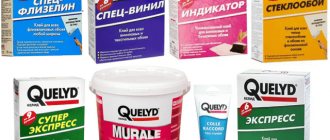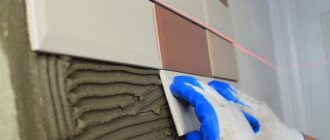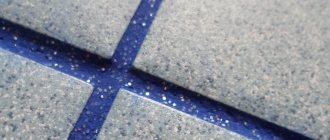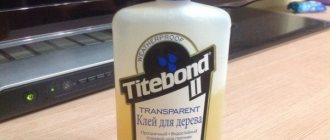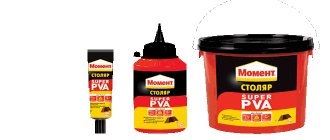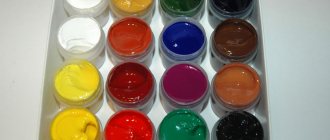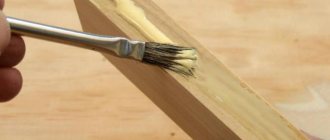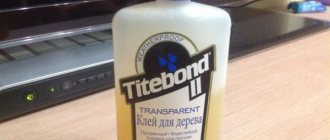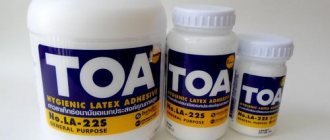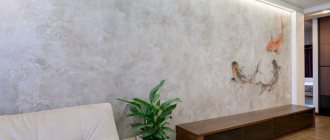Titebond is a line of wood adhesives produced by the American company Franklin International. It includes 25 compositions with different characteristics. The most popular universal one-component wood adhesive with a strong waterproof effect. If you properly prepare the base and follow all the instructions in the instructions, the resulting connection will become almost waterproof.
Composition and properties
Titebond wood glue is a professional composition that is actively used for industrial purposes and at home.
Titebond glue contains:
- Aliphatic resins.
- Polyurethanes.
- Polymers.
- Protein.
- Water.
- Synthetic rubber.
The structure of the product is abrasive, so the cutting tool will not be damaged or scratched during subsequent sawing of wooden products.
Note! In liquid form, Titebond adhesive has good chemical viscosity, which is explained by the enhanced cross-links of the substance. This makes its consistency optimal, not runny, which makes installation easier and simpler.
After hardening, Titebond assembly adhesive becomes frost-resistant, so it is suitable for application to any surfaces and objects that will be used outdoors. Among the positive properties of Titebond glue is heat resistance, but it can become flammable if the operating temperature range is exceeded from +100 degrees. In this case, the composition is flammable. It will be good to withstand temperatures up to +40 degrees.
Other features of Titebond glue:
- Tolerates exposure to solvents.
- Easily removed from the surface until completely dry.
- Initial setting occurs after 10 minutes.
- The viscosity of the glue is 4000 mPa/s.
- The acidity pH is 3 units.
- Suitable temperature conditions for working with glue are + 10-12°.
- Consumption is 170-190 g/m².
After drying, the dry residue is half of the initial volume. If all storage conditions are met, the glue can last for 2 years after opening the package.
Note! The consumption of the composition will depend on environmental conditions, as well as the type of wooden surface and the degree of its porosity.
Advantages
- Sets and hardens quickly.
- Forms a durable connection, the strength of which is higher than the wood itself.
- Suitable for carpentry work indoors and outdoors.
- Water resistance class D3.
- Working period – 7-10 minutes, clamping time – 15-20 minutes.
- Easy to apply, does not require strong pressing of parts and their installation under a press.
- The hardened seam is not destroyed under the influence of moisture, solvents, or sound waves.
- Does not contain toxic substances.
- Before complete hardening, it is easily washed off with water.
- Initially, the consistency of the glue is matte, and after hardening the seam becomes transparent.
- Resistant to temperatures from -35 °C to +40 °C.
- A universal product for gluing any types of trees, most types of plastic, combinations of different materials. Elastic types of glue work as sealants.
- The shelf life after opening the jar, provided it is stored at t=+20 °C, reaches 2 years.
Advantages and disadvantages
Titebond wood glue for wood and wooden surfaces is in great demand and popularity due to the following advantages:
- It has a world-class certificate, which confirms its high quality and reliability.
- The finished joint has high mechanical strength, higher than that of the wood itself.
- Titebond glue does not contain toxic substances, therefore it is environmentally safe. Glued parts can be used in residential areas.
- The adhesive can be used in the production of furniture, as well as in the construction industry, providing a highly durable connection of materials.
- The glue does not cling to metal, so you can choose any convenient tool for the job.
Note! Titebond wood glue also has a few disadvantages. It will not be able to reliably glue wet and painted surfaces. When using it, you must maintain the optimal temperature conditions, otherwise this will affect the quality of installation.
Precautions when working with adhesive composition
When working with any type of glue of this brand, including PVA Titebond, the following precautions must be observed:
- Wear goggles and protective gloves - they will protect the mucous membranes and prevent damage to the skin on the fingers and palms;
- If it gets on mucous membranes, it is necessary to rinse with plenty of water.
If glue gets on mucous membranes, rinse with plenty of water.
Taking into account all these features and selecting the right adhesive compositions, you can obtain reliable fixation of wooden and other types of surfaces and ensure long-term operation of the glued products.
Scope of use
Titebond glue has a very wide range of uses:
- Can be used for gluing wood of any type, species, age.
- In everyday life it is used for gluing laminate, cardboard, paper, plywood and others.
- In the woodworking industry, including for the manufacture of doors, decorative flooring, furniture.
- In the field of design - for artistic decoration of interior items with wooden parts.
- When carrying out renovation work in the house. It can serve as an analogue of sealant and provide water resistance to joints.
There are varieties of glue that have a narrow specialization. For example, glue for repairing musical instruments, a product for restoring antiques, household utensils, and wooden souvenirs.
Varieties
There are about 25 types of wood glue, which are produced in series:
- Original Wood Glue 5064 473 ml usually comes in a red bottle. It is used for working with musical instruments, as it does not affect the sound due to its solid consistency. Suitable for both wind and string instruments.
- Titebond II Premium 5004 is a one-component, moisture-resistant adhesive, available in blue packaging, with fast setting, solvent resistance and a short cure time. The finished seam of Titebond 2 glue is elastic. Typically this variety is used to make benches, garden furniture, and mailboxes. The non-toxic composition allows it to be used to repair various household items, even those that have indirect contact with food.
- Titebond 3 is a product available in green packaging that is particularly durable and water resistant. It is suitable for gluing items that have direct contact with food. There are no toxins or solvents in the composition; only safe polymers are used as a basis. Titebond 3 adhesive can even be used for gluing items that will be used in sub-zero temperatures. You can work with this composition by cold or hot gluing. The basis of the glue is a water-dispersion mixture, which makes the composition universal. Using glue you can glue not only wood, but also plastic and other materials. Consumption is 190 g/m². Polymerization times vary between 10-20 minutes.
- Heavy Duty is a very strong compound that is suitable for bonding concrete, brick, fiberglass, ceramics, stone and even hardboard. A high degree of adhesion is ensured by the synthetic rubber included in the composition. With this glue you can work even with wet and frozen wood. The frozen seam has good elasticity, due to which it is not afraid of vibration and mechanical influences.
How to use it correctly
In order for Titebond special and universal adhesives to retain all their characteristics and parameters, it is recommended to follow the following steps when using:
- Apply only at positive room temperature;
- Use only dry wood if the adhesive composition itself does not allow working with wet surfaces;
- Complete hardening usually occurs after 20 minutes;
- Before application, be sure to shake the composition to evenly distribute the components, which may peel off during long-term storage. But this does not change the quality of the glue;
- In the vast majority of cases, Titebond for wood is not recommended for use on painted surfaces;
- After opening the package, do not store for more than 2 years;
- Store containers with glue in the conditions indicated on the packaging.
Apply only at positive room temperature.
Surface preparation
The wooden surface, before applying the adhesive, must be:
- Dried;
- Cleaned from dust and dirt.
Using special solvents, any possible layer of fat and emerging oils or other types of contaminants are removed from it. If there is a paint layer, it must be cleaned.
If there is a paint layer, it must be cleaned.
Applying glue
Work with the adhesive composition should be carried out taking into account the following recommendations:
- The glue is mixed before application - shake the container vigorously enough;
- If it has thickened, for example due to cooling, then it is mixed with a brush or a clean wooden stick;
- Typically applied to one surface. This is done in a thin layer;
- Then, it is pressed against another surface and fixed for a specified time, usually 20 minutes. Excess glue that appears can be collected immediately with a damp cloth. When completely cured, they are most often cleaned mechanically;
- If it is necessary to change the position of the parts relative to each other, this must be done before the glue “sets” completely.
Typically applied to one surface. This is done in a thin layer.
Features of use
Before gluing wood to another substrate, you must first prepare both surfaces. To do this, they are cleaned of debris, dust or residue of other substances. Then the glue needs to be shaken or mixed in the bottle and applied to the base with a convenient brush.
Then fasten both surfaces.
It will take the technician 10 minutes to correct their position or remove excess glue.
Note! If glue accidentally gets on the skin, it is enough to remove the dirt with simple clean and slightly warm water.
Titebond wood glue increases the efficiency, quality and speed of any work, including repair, decorative, and production.
Application and properties of Titebond glue (2 videos)
Types and uses of Tightbond adhesives (15 photos)
Instructions for use
- Preparation of bonded surfaces. They need to be cleaned of dust and dirt. Grease stains and old finishes are removed with a sander, sandpaper, scraper, household or cleaning products, degreaser or solvent. To ensure even distribution of pressure during gluing, the thickness of the substrates to be glued should not differ by more than +/- 0.15 mm.
- Mode of application. The glue is mixed and applied to both parts to be glued. Average glue consumption is 120-150 g/m2. When gluing porous or deformed substrates, the consumption increases. The parts coated with glue are pressed tightly to prevent the parts from shifting. Compression is optional.
- Coupling time: 7-10 min. The parameter depends on the applied layer, porosity and humidity of the material, and ambient temperature.
- Pressing. The pressure applied by the press depends on the type of wood. For soft ones – from 7 kg/cm. sq., for medium hardness - from 8.8 kg/cm. sq., for hard ones - from 12.3 kg/cm. sq. The pressing time depends on the type and humidity of the wood and the air temperature.
- Recommendations after gluing. The initial bond strength is achieved after the glued part is removed from the press. The surface can be processed mechanically no earlier than on the second day after gluing. Otherwise, the dimensions of the adhesive material may change under the influence of residual moisture remaining in the seam.
- Cleaning. Wet glue can be removed with cold water. Partially dried glue is washed off with hot water. Completely hardened composition can be removed with hot steam.
